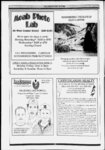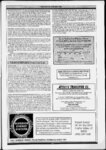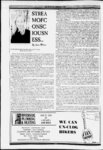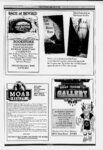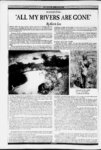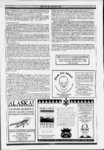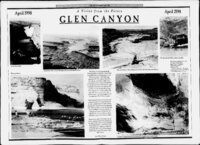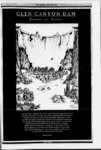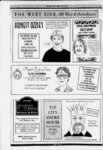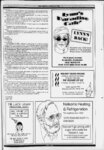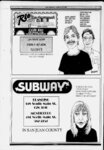| OCR Text |
Show The integrity of the dam depended upon 1" marine grade plywood holding back a body of water that extended 185 miles or so upstream. Holding back hungry water that wanted to reclaim Glen Canyon and put in its place a new rapid that some would refer fo as Dominy Falls. The river almost did if, with an inflow that was just over 100,000 cfs. In comparison we know of flows from the 1800's, through this part of the Colorado, that exceeded 300,000 cfs. Historical records from the Grand Canyon indicate that flows of 500,000 cfs have occurred. Think what that would have done. The issue is - can it happen again? The answer is - of course. The engineers that they can control any problem that arises but in reality the river will believe may eventually reclaim Glen Canyon. Did we learn our lesson from 1983? Well, the spillways have been repaired; tested at low flow levels and the engineers have said they are ok. Glen Canyon Dam is still wedged between the sandstone walls and the engineers sit behind their desks computer models and predict that the Colorado River is again controlled. The truth is that the dam dodged a big one in 1983. The scenarios are endless. The engineers are only human and the dam is only made of concrete. With the changes in world climate and increasing severity of storms, it is probable that another event will occur. We have been lucky but nature and history indicate that the inevitable combination of forces and events will return the river to the Canyon. THANKS TO THE GLEN CANYON INSTITUTE... RICHARD JJNGEBRETSEN, MD, Fh. D. President and founder of the Glen Canyon Institute, Richard Ingebretsen floated Glen Canyon a year before the impounded waters of the new reservoir began to rise behind Glen Canyon Dam. He never forgot Almost 35 years later, the Glen Canyon Institute invited leading scientists, engineers and the Bureau of reclamation to discuss the issue of draining Lake Powell. Other environmental groups, including the Sierra Club's board of directors, have endorsed the Institute's proposal to drain the reservoir. It is a movement that continues to gain momentum. Dr. Ingebretsen is Research Associate Professor in the Physics department at the University of Utah and Clinical Instructor in the U of U's Department of Medicine. He was bom in Salt Lake Gty DAVID WEGNER.. Dave Wegner has over 25 years experience as a practicing scientist, scientific coordinator, manager and administrator. A former employee of 22 years for the United States Bureau of Reclamation, he currently runs his own scientific consulting firm in Flagstaff, Arizona. Dave was principle scientist and Program Manager for the Glen Canyon Environmental Studies Program. This program, run through the Department's Bureau of Reclamation, focused on the evaluation of environmental impacts associated with the operation of Glen Canyon Dam. The program cost $70 million and required extensive coordination between hundreds of scientists, administrators, tribal leaders, congressional staff, power and water users, the public, academic institutions and the National Research Council. The program culminated in the successful completion of the Glen Canyon Dam Environmental Impact Statement, two Glen Canyon Dam Biological Opinions, a Programmatic Agreement with eight Native American tribes, and the application of the first experimental flood for ecological purposes in the Grand Canyon. The Glen Canyon Institute is extremely fortunate to have the talents and competence of Mr. Wegner directing its Gtizens' Environmental Assessment. AND SPECIAL THANKS FROM THE ZEPHYR TO DENISE BOGGS I don't think this issue of the Zephyr would have ever found its way to press without the super human efforts of the Glen Canyon Institute's Development Director, Denise Boggs. While the publisher of this rag was off drinking Swan beer with the likes of Little Jimmie Baker, Denise made sure that writing deadlines were met and that, to the great relief of this publication, they were all put on a three inch disk in Word Perfect 5.1. Already behind schedule and faced with editing Katie Lee's story to fit the limited space available, Denise stepped in for me and transcribed Katie's great tale of Glen Canyon. Her help in tracking down new Glen Canyon photographs was also a great help. However, Denise's talents go far beyond covering for disorganized editors. Denise has spent the last 15 years working with environmental organizations. Denise holds degrees in wildlife biology and public administration and is known for her expertise in the NEPA process. She has lectured throughout the West on that subject and her workshop materials are available from the University of Oregon and the University of Montana law schools. Denise will soon assume responsibilities as NEPA Coordinator for the Glen Canyon Institute's Citizens' EA. PHOTOGRAPHS: Opposite page. Debris from the spillway tunnel once the flood had subsided. Above: Inside the spillway at the elbow. OPEN 7AM to CLOSE SEVEN DAYS A WEEK Lunch Breakfast Dinner aVIS EATS HERE vm 5 North In the heart O A VTAH Mail Street of Downtown (435)259-800- 4 Moab |





